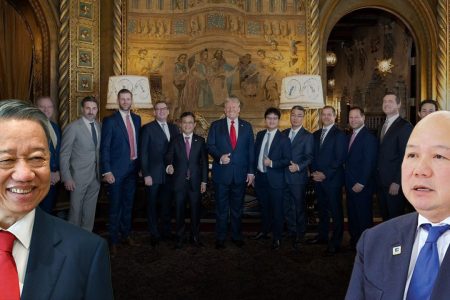
A recent video shows Chinese soldiers hurling stones and cursing at unarmed Vietnamese construction workers in Ha Giang province, which borders China. The event took place in the context of Vietnam’s agricultural exports being stagnated when thousands of trucks carrying agricultural products were blocked for weeks at the border because of China’s new epidemic prevention policy.
A video posted on Twitter by an account named „Lee Ann Quann“ on January 3 shows dozens of Chinese soldiers hurling stones at excavators believed to belong to a group of Vietnamese workers along the riverbank in Vietnam to prevent erosion.
Commenting on the incident, Dr. Ha Hoang Hop, a guest senior researcher at the ISEAS Institute (Institute of Southeast Asian Studies) in Singapore, told VOA that it can be confirmed that the actions of the Chinese soldiers are due to „receiving orders from Beijing.“
He added: “The Chinese do not allow Vietnamese workers to build on Vietnam’s side of the stream. Their reasoning was that it would block the water and (make) the water flow towards China’s shore, eroding the Chinese side and knocking down the fence China built there. They spoke very clearly and even displayed protest slogans in Vietnamese and Chinese.“
The Vietnamese side then explained that the embankment did not affect China and continued construction should lead to the „stoned“ incident, still according to Dr. Ha Hoang Hop.
“On the other side, China, if they say no, then they send people to protest, but if they can’t anymore, they throw stones. They didn’t throw at the Vietnamese workers, but they threw at the excavators. Not a single Vietnamese person was injured,“ Dr. Ha Hoang Hop said.
The act of „throwing stones“ by the Chinese towards Vietnam, he said, is exactly the same as what happened in the early stages of the border conflict between China and India.
“At first, the Chinese just threw stones at the Indians‘ tents on the border, which were empty tents where Indian soldiers kept food, rice, feed, and pigs… But then that (conflict) increased very quickly, (China) began to throw at the tents where the (Indian) soldiers lived, then threw stones at each other, fought, pushed each other to death,“ Dr. Ha Hoang Hop said, saying this is a „not good“ sign, although the possibility of an armed conflict like in the case of India is not high „but it is not zero.“
According to a researcher of the ISEAS Institute, the relations between Vietnam and China so far cannot be considered „peaceful“ because even though there is no gunfire, the two neighboring countries have long been in a state of „war“ on many fronts.
„Not fighting with guns, but fighting with information first: information war„, Dr. Ha Hoang Hop said. He cited the most recent incident that happened this week when a director of the Chinese government’s South China Sea Institute published an article in the country’s largest daily newspaper „China Today„, saying that Vietnam’s maritime militia has built 400-ton iron ships, instead of traditional wooden ships, which are equipped with weapons such as water cannons, guns, archery machines… and even act like pirates, robbers and threaten fishing boats of other countries.
„They slandered Vietnam, and that’s the simplest thing about information warfare,“ said Dr. Ha Hoang Hop said.
Another „very strong“ war that is also happening between Vietnam and China is the cyberwar. Tens of thousands of attacks from outside, mainly from China, on Vietnamese computer networks every week is an example, still according to Dr. Ha Hoang Hop.
A rather typical feature is that China often applies „gray zone tactics“ in wars in all fields towards Vietnam, from sending so-called „research ships“ across the seas belonging to Vietnam to the recent event in which China applies the „Zero COVID“ policy, which Dr. Ha Hoang Hop said it was a „false excuse“ to justify Beijing’s pressured actions to block the border area, causing havoc for Vietnamese agricultural products.
To sum up, the actual actions show that China has a coherent and integrated attack plan in all areas targeting neighboring countries that have sovereignty disputes with them, especially Vietnam.
Particularly in the field of border trade, in addition to the reasons in the style of „making excuses“ of China, Dr. Ha Hoang Hop said that the Vietnamese side also needs to recognize and adjust its business practices in line with international standards, in order to be able to deal with a China that is „to learn hard“ international regulations since the country entered the International Trade Organization (WTO).
He said: “From the Vietnamese side, they must also see that they need to learn and implement trade regulations, from goods quality to hygiene, standards… rather than going there and laughing together and saying ‚You can buy it after we decrease prices‘. That will not work!“
However, Dr. Ha Hoang Hop noted that even if Vietnamese enterprises strictly comply with international trade standards, the possibility that the Chinese side will continue to use tricks to pressure and cause damage for Vietnam is not excluded.
Thoibao.de (Translated)
























